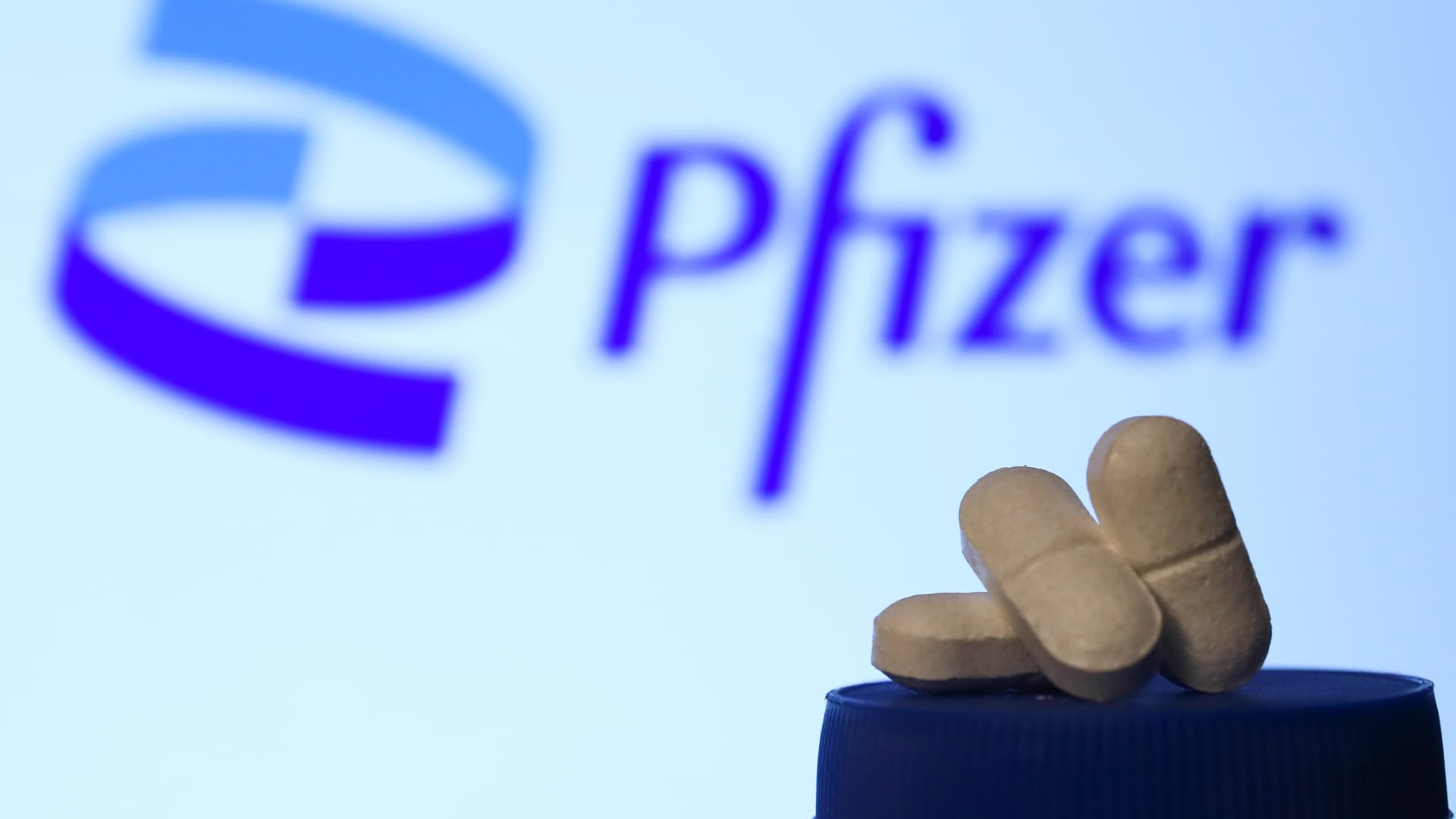Pfizer is betting big on cancer drugs to turn business around after Covid decline – here’s what to know
Pfizer is betting big on cancer drugs to turn business around after Covid decline – here's what to know CNBC


Pfizer Shifts Focus to Cancer Drugs to Recover from Decline in Covid Business

Pfizer’s Transition to Oncology
Pfizer is ready to move on from Covid. Now, the company is betting on cancer drugs to help it regain its footing after a rocky year marked by the rapid decline of its Covid business. It just might take a while before that bet pays off.
Pfizer pitched its deeper push into oncology during a four-hour investor event last week. And it had a splashy 60-second Super Bowl ad that touted its initiative to “outdo cancer.”
The shift comes at a crucial time for Pfizer. The pharmaceutical giant has been trying to shore up investor sentiment after its shares fell more than 40% in 2023. That share drop erased more than $100 billion in Pfizer’s market value.
During the investor day, Pfizer laid out its priorities now that it has fully integrated with the targeted cancer drugmaker Seagen. That $43 billion Seagen acquisition doubled Pfizer’s oncology drug pipeline to 60 different experimental programs.
With Seagen under its belt, Pfizer says its drug pipeline could produce at least eight blockbuster medicines by 2030, up from just five today. But the company did not disclose which drugs it believes could offer that potential.
Some analysts noted that it might take a few years for some of Pfizer’s cancer drugs in mid-stage development to show pivotal clinical trial data and become less risky.
Pfizer’s existing oncology portfolio is also facing some competitive pressure. Revenue from the blockbuster breast cancer drug Ibrance and prostate cancer treatment Xtandi, which Pfizer shares with Astellas Pharma, has declined over the past year. Both drugs are expected to lose market exclusivity in 2027.
Still, some analysts came out of the investor day feeling encouraged. “The company is facing a number of challenges, but we believe the event was a success in laying out a path for the oncology business to help offset upcoming patent losses, and drive growth in the future,” Guggenheim analysts wrote in a note Tuesday.
Long-term Commercial Strategy
Pfizer used the investor event to formally introduce its new business division dedicated to cancer research and to lay out a long-term strategy for it through the end of the decade.
That oncology unit hosts a sprawling portfolio of experimental medicines that Pfizer and Seagen discovered or acquired through deals, as well as the treatments both companies have long been selling.
The unit is led by Chris Boshoff, a longtime Pfizer executive who most recently served as the company’s head of cancer research and development.
Boshoff highlighted the scale of Pfizer’s capabilities, noting it has 10 manufacturing sites producing cancer drugs on three continents, while Seagen had just one. He also pointed to Pfizer’s commercial presence in more than 100 countries and a customer-facing commercial team that is triple the size of Seagen’s.
Pfizer did not provide a specific sales projection for its oncology franchise by 2030. But the company said it expects roughly two-thirds of risk-adjusted oncology revenue to come from new drugs and new indications — or treatment uses — for existing products by the end of the decade.
A New Focus
Pfizer also highlighted a huge shift in its drug pipeline strategy. Boshoff said the oncology division plans to shift to biologic drugs as its main source of revenue, increasing the proportion of those treatments in its pipeline from 6% to 65% by 2030.
Biologics are treatments derived from living sources such as animals or humans, including vaccines, stem cell treatments and gene therapies. They are among the most expensive prescription drugs in the U.S.
Before the Seagen deal, 94% of Pfizer’s cancer products were small-molecule drugs. Those medicines are made of chemicals and have low molecular weights.
Boshoff said biologics represent “a more durable revenue potential” based on several factors. That includes upcoming patent expirations and potential pressure from President Joe Biden’s Inflation Reduction Act.
A provision of that law allows Medicare to start negotiating the prices of biologics as early as 13 years after they receive Food and Drug Administration approval, compared with just nine years for small-molecule drugs. The pharmaceutical industry has argued that would deter drugmakers from investing in small molecules.
Pfizer’s decision to rely more on biologics may also offer “better protection” against competition from cheaper copycats, Guggenheim analysts said in their note. Those copycats, or biosimilars, have historically had trouble gaining market share from biologic treatments. That’s unlike with drugs called generics, which are exact copies of small-molecule treatments.
Small molecules will remain one of three core drug types of Pfizer’s oncology division. The other two are biologics, namely bispecific antibodies, and antibody-drug conjugates, or ADCs.
Pfizer’s three core oncology drug types
- Small-molecule drugs: Treatments with a low molecular weight made up of chemicals created in a lab.
- Bispecific antibodies: Treatments that can bind to two different antigens — or any substance that causes the body to have an immune response — at the same time. Those drugs are biologics because they are developed from living sources that produce antibodies.
- Antibody-drug conjugates: Medications that deliver a cancer-killing therapy to specifically target and kill cancer cells and minimize damage to healthy ones. The treatments represent a hybrid between biologics and small-molecule drugs, but the FDA classifies ADCs as biologics.
Notably, the company is developing a “next-generation” platform for ADCs that combines Pfizer’s protein engineering and antibody design capabilities with Seagen’s ADC technology. Together, the companies have 12 ADCs in development, six of which are in early clinical trials or studies on animals.
Four Core Cancer Types
Pfizer plans to focus on four main types of cancer: breast cancer; genitourinary cancer, which impacts urinary and genital organs or functions; thor
SDGs, Targets, and Indicators
1. Which SDGs are addressed or connected to the issues highlighted in the article?
- SDG 3: Good Health and Well-being
- SDG 9: Industry, Innovation, and Infrastructure
- SDG 12: Responsible Consumption and Production
- SDG 17: Partnerships for the Goals
2. What specific targets under those SDGs can be identified based on the article’s content?
- SDG 3.4: By 2030, reduce by one-third premature mortality from non-communicable diseases through prevention and treatment and promote mental health and well-being.
- SDG 9.5: Enhance scientific research, upgrade the technological capabilities of industrial sectors in all countries, in particular developing countries, including, by 2030, encouraging innovation and increasing the number of research and development workers per 1 million people by x percent annually.
- SDG 12.2: By 2030, achieve the sustainable management and efficient use of natural resources.
- SDG 17.16: Enhance the global partnership for sustainable development, complemented by multi-stakeholder partnerships that mobilize and share knowledge, expertise, technology, and financial resources.
3. Are there any indicators mentioned or implied in the article that can be used to measure progress towards the identified targets?
- Indicator for SDG 3.4: Premature mortality rate from cancer.
- Indicator for SDG 9.5: Number of research and development workers per 1 million people.
- Indicator for SDG 12.2: Domestic material consumption per capita.
- Indicator for SDG 17.16: Amount of financial resources mobilized to support the achievement of the sustainable development goals.
Table: SDGs, Targets, and Indicators
| SDGs | Targets | Indicators |
|---|---|---|
| SDG 3: Good Health and Well-being | 3.4: By 2030, reduce by one-third premature mortality from non-communicable diseases through prevention and treatment and promote mental health and well-being. | Premature mortality rate from cancer. |
| SDG 9: Industry, Innovation, and Infrastructure | 9.5: Enhance scientific research, upgrade the technological capabilities of industrial sectors in all countries, in particular developing countries, including, by 2030, encouraging innovation and increasing the number of research and development workers per 1 million people by x percent annually. | Number of research and development workers per 1 million people. |
| SDG 12: Responsible Consumption and Production | 12.2: By 2030, achieve the sustainable management and efficient use of natural resources. | Domestic material consumption per capita. |
| SDG 17: Partnerships for the Goals | 17.16: Enhance the global partnership for sustainable development, complemented by multi-stakeholder partnerships that mobilize and share knowledge, expertise, technology, and financial resources. | Amount of financial resources mobilized to support the achievement of the sustainable development goals. |
Behold! This splendid article springs forth from the wellspring of knowledge, shaped by a wondrous proprietary AI technology that delved into a vast ocean of data, illuminating the path towards the Sustainable Development Goals. Remember that all rights are reserved by SDG Investors LLC, empowering us to champion progress together.
Source: cnbc.com

Join us, as fellow seekers of change, on a transformative journey at https://sdgtalks.ai/welcome, where you can become a member and actively contribute to shaping a brighter future.







